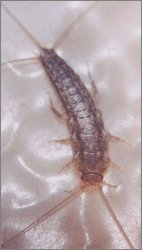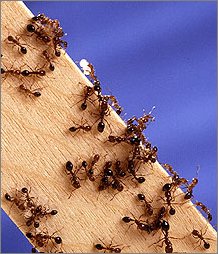Which Pest Insects Pose Dangers to You (and Which are Just Merely Gross)?
by www.SixWise.com
Many creepy crawly creatures make their appearance quite known during these "dog days" of summer and into early autumn. Putting the yuck-factor aside, some common insect pests are more than just gross, they can actually be dangerous.
Pay attention to the insects that are harmless versus those that can cause harm -- that way you'll be able to act fast if a dangerous bug crosses your path (and you'll have a valid excuse when others make fun of the way you acted!)
|

Though undoubtedly gross, silverfish are not dangerous to people.
|
The Risky Pests
1. Fire Ants
Fire ants are not only aggressive, but they can also use pheromones to communicate and attack in unison.
"Once the signal is given, you might get 15, 20 or even 30 or 40 bites all at one time," said retired field entomologist Homer Wilson. "They are very aggressive insects."
Fire ant stings are painful and also contain toxins that can be dangerous in large amounts, or to small children.
"A very small child could be very much in danger," Wilson said. "[Once bitten] a child may go into a high fever ... and even possibly go to the hospital if they have an allergic reaction ... They are actually able to kill young calves and other small animals."
Fire ant bites can be treated with a medicated cream to relieve pain but should be watched for signs of infection or allergic reaction like trouble breathing or swelling.
2. Mosquitoes
Mosquito bites are, of course, itchy and sometimes a bit painful, but mosquitoes' real risk comes from their ability to transmit disease. In this part of the world, mosquitoes can carry West Nile Virus, and about one in 150 people bitten will develop a serious case.
In severe cases, symptoms include headache, high fever, stiff neck, disorientation, muscle weakness, tremors and paralysis, so if you notice these symptoms about two to 15 days after being bit by a mosquito, see a health care practitioner right away.
3. Brown Recluse Spider
Brown recluse spider venom is toxic but the bite may go unnoticed, as it feels much like a mosquito bite. However, the bite will become surrounded by a spreading rash that can eat away flesh, cause scarring and even the loss of a limb.
"Basically, during the summertime any signs of infection should be seen by a medical provider," said Dr. William Marcy of the Mantachie Clinic in Mississippi.
|

Fire ants use pheromones to communicate and coordinate attacks.
|
4. Ticks
Ticks bite animals, including humans, to feed on their blood, and in doing so can transmit diseases including Rocky Mountain spotted fever, Lyme disease (a potentially serious bacterial infection that causes a rash and flu-like symptoms including fatigue, headache, stiffness or pain in neck, muscles and joints, fever and swollen glands), babesiosis (Texas fever), ehrlichiosis, tularemia, Colorado tick fever and Powassan (a form of encephalitis).
Keeping your yard well maintained, trimmed and mowed will help to keep ticks away, as will keeping your pets tick-free.
If you find a tick on your pet, the completely pesticide-free and safe Flea 'n Tick B Gone can be sprayed directly onto the tick to help with removal. Unlike the other tick and flea treatments on the market, Flea 'n Tick B Gone does not contain harmful pesticides or chemicals, such as DEET, pyrethrins, synthetic pyrethroids or permethrin, all of which can be harmful and irritating to your pet, the person applying them and our environment.
5. Bees, Wasps and Hornets
Although bees are not aggressive and typically won't sting unless disturbed (such as if you step on one while walking barefoot), yellow jackets, wasps and hornets can be aggressive.
Most stings result in local swelling, pain, itching and redness, and in uncommon circumstances infection can occur. In those who are allergic to the venom, however, a sting can be life-threatening.
Allergic reactions to stings are treated with epinephrine (adrenaline). People who are allergic to stings can get a prescription for a self-injectable device (Epi-Pen, ANA-Kit, etc.) that they can use to treat themselves in the event they are stung. However, more than one dose is often needed, so emergency help may still be called for.
|
Flea 'n Tick B Gone: The Natural and Safe Way to Beat Fleas, Ticks and Other Pests
 Flea 'n Tick B Gone is an enzyme-based formula made naturally from plant resources, so it's entirely free of the neurotoxic pesticides that make up conventional flea and tick treatments. Flea 'n Tick B Gone is: Flea 'n Tick B Gone is an enzyme-based formula made naturally from plant resources, so it's entirely free of the neurotoxic pesticides that make up conventional flea and tick treatments. Flea 'n Tick B Gone is:
- 100% Pesticide Free
- Non-toxic
- Clinically proven to be highly effective
- A Great Value! Eliminates the need for collars, bombs, foggers, powders, etc., and is economically priced
- Can also be used on bedding and pet areas of the home--Simply lightly spray in these areas
- Reduces vet and medicinal costs
- Can safely be used as a preventive against fleas and ticks: Regular use can naturally break life cycle of fleas
- Controls other in-home pests
- Reduces risk of infections, dermatitis and itching
- Safely removes fleas, ticks, lice and other pests
Read more about
Flea n' Tick B Gone Now!
|
6. Houseflies
Although houseflies don't bite humans, they do hover around less-than-sanitary places like garbage and sewage. Houseflies "sponge" up food using a spongy part of their mouth, and when they land on your food they can leave behind typhus, dysentery, tuberculosis, poliomyelitis, cholera, pinworms, hookworms and some tapeworms.
Gross -- but Not-so-Risky -- Pests
Most bugs around the house, though gross, are not dangerous to humans (unless infestations grow to huge numbers, such as with bacteria-carrying roaches). So even though it may not make them any more appealing, you can take some comfort in knowing that these insects are virtually harmless.
- Earwigs
- Silverfish
- Most spiders
- Most Beetles
- Crickets
- Daddy-Long-Legs
- Dragonflies
- Millipedes
|
- Mayflies
Beetles
- Boxelder bugs
- Cockroaches
- Grasshoppers
- Caterpillars
- Butterflies
- Cicadas
|
Recommended Reading
Bugs that Bite: Interesting Facts & Necessary Precautions on the Insects That Crave You
How Many Insect Parts and Rodent Hairs are Allowed in Your Food?
Sources
Itawamba County Times July 11, 2006
KXAN.com July 12, 2006